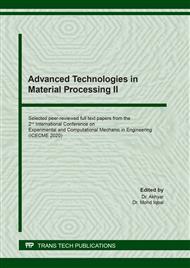[1]
P. Yanzhou, H. Shuguang, and D. Qingjun, Preparation of Reactive Powder Concrete Using Fly Ash and Steel Slag Powder, J. Wuhan Univ. Technol., Sci. Ed, (2010) 349–354.
DOI: 10.1007/s11595-010-2349-0
Google Scholar
[2]
H. Yazici, M. Y. Yardimci, H. Yiǧiter, S. Aydin, and S. Türkel, Mechanical properties of reactive powder concrete containing high volumes of ground granulated blast furnace slag, Cem. Concr. Compos., 32 No.8, (2010) 639–648.
DOI: 10.1016/j.cemconcomp.2010.07.005
Google Scholar
[3]
N. Van Tuan et al., The study of using rice husk ash to produce ultra high performance concrete, Constr. Build. Mater., 25 No.4, (2011) 2030–(2035).
DOI: 10.1016/j.conbuildmat.2010.11.046
Google Scholar
[4]
W. Kushartomo, I. Bali, and B. Sulaiman, Mechanical behavior of reactive powder concrete with glass powder substitute, Procedia Eng., 125, (2015) 617–622.
DOI: 10.1016/j.proeng.2015.11.082
Google Scholar
[5]
W. Huang, H. Kazemi-kamyab, W. Sun, and K. Scrivener, Effect of cement substitution by limestone on the hydration and microstructural development of ultra-high performance concrete (UHPC), Cem. Concr. Compos., 77, (2017) 86–101.
DOI: 10.1016/j.cemconcomp.2016.12.009
Google Scholar
[6]
T. Saidi, M. Hasan, A. D. D. Riski1, R. R. Ayunizar, and A. Mubarak, Mix design and properties of reactive powder concrete with diatomaceous earth as cement replacement, IOP Conf. Ser. Mater. Sci. Eng., 933 012007, (2020).
DOI: 10.1088/1757-899x/933/1/012007
Google Scholar
[7]
M. Hasan, T. Saidi, A. Muyasir, Y. R. Alkhaly, and M. Muslimsyah, Characteristic of calcined diatomaceous earth from Aceh Besar District - Indonesia as cementitious binder, OP Conf. Ser. Mater. Sci. Eng., 933 012008, (2020).
DOI: 10.1088/1757-899x/933/1/012008
Google Scholar
[8]
R. Yu, P. Spiesz, and H. J. H. Brouwers, Mix design and properties assessment of Ultra-High Performance Fibre Reinforced Concrete (UHPFRC), Cem. Concr. Res., 56, (2014) 29–39.
DOI: 10.1016/j.cemconres.2013.11.002
Google Scholar
[9]
P. Richard and M. Cheyrezy, Composition of Reactive Powder Concretes, Cem. Concr. Res., 25 No.7, (1995) 1501–1511.
DOI: 10.1016/0008-8846(95)00144-2
Google Scholar
[10]
K. Wille, A. E. Naman, and G. J. Parra-Montesinos, Ultra-High Performance Concrete with Compressive Strength Exceeding 150 MPa (22ksi): A Simpler Way, ACI Mater. J., 108 No.1, (2011) 46–53.
DOI: 10.14359/51664215
Google Scholar
[11]
S. Ahmad, I. Hakeem, and M. Maslehuddin, Development of UHPC Mixtures Utilizing Natural and Industrial Waste Materials as Partial Replacements of Silica Fume and Sand, Sci. World J., 2014, (2014) 1–8.
DOI: 10.1155/2014/713531
Google Scholar
[12]
N. P. Lee and D. H. Chisholm, Reactive Powder Concrete. Study Report SR 146, BRANZ Ltd., Judgeford, New Zealand.
Google Scholar
[13]
M. Ángel, C. Argiz, J. C. Gálvez, and A. Moragues, Effect of silica fume fineness on the improvement of Portland cement strength performance, Constr. Build. Mater., 96, (2015) 55–64.
DOI: 10.1016/j.conbuildmat.2015.07.092
Google Scholar
[14]
H. Yigiter, S. Aydin, H. Yazici, and M. Y. Yardimci, Mechanical Performance of Low Cement Reactive Powder Concrete (LCRPC), Compos. Part B Eng., 43 No.8, (2012) 2907–2914.
DOI: 10.1016/j.compositesb.2012.07.042
Google Scholar
[15]
E. Ghafari, S. A. Ghahari, H. Costa, E. Júlio, and L. Durães, Effect of supplementary cementitious materials on autogenous shrinkage of ultra-high performance concrete, Constr. Build. Mater., 127, (2016) 43–48.
DOI: 10.1016/j.conbuildmat.2016.09.123
Google Scholar
[16]
A. Alsalman, C. N. Dang, and W. M. Hale, Development of ultra-high performance concrete with locally available materials, Constr. Build. Mater., 133, (2017) 135–145.
DOI: 10.1016/j.conbuildmat.2016.12.040
Google Scholar
[17]
M. A. Elrahman and B. Hillemeier, Combined effect of fine fly ash and packing density on the properties of high performance concrete : An experimental approach, Constr. Build. Mater., 58, (2014) 225–233.
DOI: 10.1016/j.conbuildmat.2014.02.024
Google Scholar
[18]
M. N. Mangulkar and S. S. Jamkar, Review of Particle Packing Theories Used For Concrete Mix Proportioning, Int. J. Sci. Eng. Res., 4 No.5, (2013) 143–148.
Google Scholar
[19]
Elkem, User Guide Elkem Materials Mixture Analyser – EMMA. 2016, (2016).
Google Scholar
[20]
C. M. Tam, V. W. Y. Tam, and K. M. Ng, Assessing drying shrinkage and water permeability of reactive powder concrete produced in Hong Kong, Constr. Build. Mater., 26 No.1, (2012) 79–89.
DOI: 10.1016/j.conbuildmat.2011.05.006
Google Scholar


